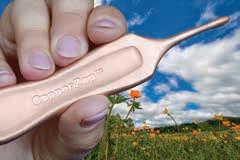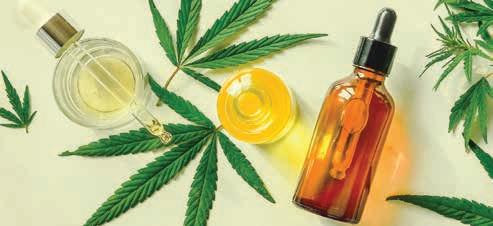
7 minute read
HEMP GETS HOT
HEMP GETS HOT Meet the Hardest Working Plant on the Planet
by Julie Peterson A crop that was illegal in U.S. soil for more than half a century is now reaching for the sun. Industrial hemp, the low- or no-THC cousin to marijuana, has created high hopes among farmers, agricultural researchers, manufacturers and consumers. By 2019, America had become the world’s third-largest producer, behind Canada and China, where it’s been cultivated for 8,500 years. “It’s the fastest-growing ag industry that we’ve ever seen,” says Tara Valentine, hemp specialist at the Rodale Institute, in Kutztown, Pennsylvania. Since hemp’s inclusion in the 2018 Farm Bill, Rodale’s hemp web page hits have grown 10-fold. Better Products All parts of the hemp plant are useful in multiple ways, and hemp has applications in textiles, construction, bioremediation, technology, nutrition and health, including cannabidiol (CBD). Th e seeds are rich in protein, essential fatty acids and vitamins. Th ey can be eaten, ground into fl our or pressed for oil that is used for cooking or in body care products. Th e stems undergo decortication to separate the long outer fi bers (bast) from the short inner fi bers (hurd). Hemp hurd makes extremely durable hempcrete for construction, absorbent and dust-free animal bedding or pellets for heating stoves. An exponential rise in the use of hemp is expected because it can replace products made from paper, wood, plastic, cotton and fossil fuels. “Hemp fi ber is going to dominate the market once we get to the full manufacturing potential,” says Erica Stark, executive director of the National Hemp Association, in Washington, D.C. Th e fi rst introductions consumers can expect include hemp paper products, such as plates and toilet paper, and biodegradable hemp bioplastics like cutlery and cups. Construction materials and other products are expected to quickly follow. Environmentally Friendly Th e Institute of Papermaking and Printing, at the Technical University of Lodz, Poland, did a 2015 study comparing making paper from wood to making it from hemp. Among the fi ndings: hemp takes four months to grow, while trees need 20 to 80 years. An acre of hemp can produce four or more times as much paper as an acre of trees. Hemp paper doesn’t need toxic bleaching and can be recycled twice as many times. Other studies concur. Paper without deforestation would be a major benefi t, but it’s a minor job on hemp’s profound résumé. “Hemp needs to be a part of every climate change conversation, not only because it sequesters huge amounts of carbon during cultivation, but also because construction products made by Julie Peterson Right now, it’s the Wild West of agriculture. ~Dustin Enge
Advertisement
out of hemp will continue to sequester carbon for up to 100 years,” says Stark. Hemp could also help save the depleted soil on U.S. farmland that has been destroyed by tilling and synthetic fertilizers. “We have to rebuild the soil by putting carbon back in and increasing organic matter,” says Valentine. Hemp does this with a massive root biomass that breaks up compacted soils, improves water infi ltration and reduces runoff and erosion. Fast-growing hemp naturally suppresses weeds, needs no pesticides and isn’t picky about soil, water or latitude. By comparison, cotton is water-intensive and uses 25 percent of the world’s pesticides.
Income for Farmers Used in crop rotation, hemp’s soilenhancing qualities can increase profi ts on subsequent crops. While cover crops don’t usually have return value, hemp provides additional revenue streams. But the revenue isn’t quite there yet, because the supply chain isn’t complete. Seed supply, farm equipment, education, processing facilities and manufacturers are all links that are developing simultaneously. “Fiber processing facilities will be available soon. Manufacturers are anxious to start incorporating hemp,” says Stark. Th e lack of buyers isn’t deterring farmers. Neither are warnings that current harvesting equipment can spark disaster when hemp fi ber wraps around rotating parts, heats up and combusts. Dustin Enge, a third-generation farmer in Prairie du Sac, Wisconsin, started Honey Creek Hemp in 2017. He planted six acres of hemp. “I think it’s a long-term viable commodity for farmers. Right now, it’s the Wild West of agriculture. Everyone is trying diff erent things,” says Enge, who modifi ed a harvester for hemp. “I spent about two hours harvesting and 20 hours torching the fi ber off my equipment.” Even so, he will plant more acres when he knows it will sell. Behold the sprouting of the hemp industry as an ancient plant takes root in the modern world.
Julie Peterson writes from rural Wisconsin and can be reached at JuliePeterson2222@ gmail.com.

13 March 2020 S cientists recently discovered a way to kill viruses and bacteria. Now thousands of people are using it to stop colds and fl u. Colds start when cold viruses get in your nose. Viruses multiply fast. If you don’t stop them early, they spread and cause misery. In hundreds of studies, EPA and university researchers have confi rmed that viruses and bacteria die almost instantly when touched by copper.
That’s why ancient Greeks and Egyptians used copper to purify water and heal wounds. They didn’t know about microbes, but now we do.
Scientists say the high conductance of copper disrupts the electrical balance in a microbe cell and destroys the cell in seconds.
Tests by the EPA (Environmental Protection Agency) show germs die fast on copper. So some hospitals tried copper for touch surfaces like faucets and doorknobs. This cut the spread of MRSA and other illnesses by over half, and saved lives.
The strong scientifi c evidence gave inventor Doug Cornell an idea. When he felt a cold about to start he fashioned a smooth copper probe and rubbed it gently in his nose for 60 seconds.
“It worked!” he exclaimed. “The cold never got going.” It worked again every time. He hasn’t had a single cold for 7 years since.
He asked relatives and friends to try it. They said it worked for them, too, so he patented CopperZap™ and put it on the market.
Soon hundreds of people had tried it and given feedback. Nearly 100% said the copper stops colds if used within 3 hours after the fi rst sign. Even up to 2 days, if they still get the cold it is milder than usual and they feel better.
Users wrote things like, “It stopped my cold right away,” and “Is it supposed to work that fast?”
Pat McAllister, 70, received one for Christmas and called it “one of the best presents ever. This little jewel really works.”
Now thousands of users have simply stopped getting colds.
People often use CopperZap preventively. Frequent fl ier Karen Gauci used to get colds after crowded fl ights. Though skeptical, she tried it several times a day on travel days for 2 months. “Sixteen fl ights and not a sniffl e!” she exclaimed.
Businesswoman Rosaleen says when people are sick around her she uses CopperZap morning and night. “It saved me last holidays,” she said. “The kids had colds going round and round, but not me.”
Some users say it also helps with sinuses. Attorney Donna Blight had a 2-day sinus headache. When her CopperZap arrived, she tried it. “I am shocked!” she said. “My head cleared, no more headache, no more congestion.” Some users say copper stops nighttime stuffi ness if used just before bed. One man said, “Best sleep I’ve had in years.”
Copper can also stop fl u if used early and for several days. Lab technicians placed 25 million live fl u viruses on a CopperZap. No viruses were found alive soon after.
Dr. Bill Keevil led one of the teams confi rming the discovery. He placed millions of disease germs on copper. “They started to die literally as soon as they touched the surface,” he said. People have even used copper on cold sores and say it can completely prevent outbreaks. The handle is curved and fi nely textured to improve contact. It kills germs picked up on fi ngers and hands to protect you and your family. Copper even kills deadly germs that have become resistant to antibiotics. If you are near sick people, a moment of handling it may keep serious infection away. It may even save a life.
The EPA says copper still works even when tarnished. It kills hundreds of diff erent disease germs so it can prevent serious or even fatal illness.
CopperZap is made in America of pure copper. It has a 90-day full money back guarantee. It is $69.95.
Get $10 off each CopperZap with code NATA18. Go to www.CopperZap.com or call toll-free 1-888-411-6114.
Buy once, use forever. New research: Copper stops colds if used early.
ADVERTORIAL Seven years without a cold? New device stops cold and fl u
Dr. Bill Keevil: Copper quickly kills cold viruses.






